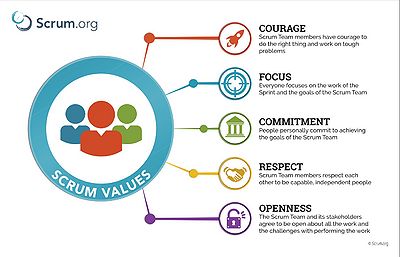Scrum 2
(Created page with " == Introduction == Scrum was introduced in 1986 by Hirotaka Takeuchi and Ikujiro Nonaka with an article named: ‘The New New Product Development Game’, published by Harva...") |
(→Values) |
||
| Line 19: | Line 19: | ||
== Values == | == Values == | ||
| + | [[File:Scrum values.jpg|400px|right|Fig 1: Scrum.org: Author]] | ||
The Scrum framework is based upon 5 core values that are meant to help illustrate some of benefits of the framework. The five values are: | The Scrum framework is based upon 5 core values that are meant to help illustrate some of benefits of the framework. The five values are: | ||
| Line 31: | Line 32: | ||
- Openness | - Openness | ||
| − | For a Scrum process to be successful, the scrum team must keep these values in mind. The teams must be courageous so that they can use this framework to solve tough and complex issues. Focus and Commitment are also essential. When working with complex issues it is important that the team participating in the process are focused and committed. Finally, this framework is used by teams of people and therefore the participants are forced to work together. To help ensure conflicts are avoided, participants are encouraged to be respectful and open towards their fellow teammates.[[File:Scrum values.jpg|400px | + | For a Scrum process to be successful, the scrum team must keep these values in mind. The teams must be courageous so that they can use this framework to solve tough and complex issues. Focus and Commitment are also essential. When working with complex issues it is important that the team participating in the process are focused and committed. Finally, this framework is used by teams of people and therefore the participants are forced to work together. To help ensure conflicts are avoided, participants are encouraged to be respectful and open towards their fellow teammates.[[File:Scrum values.jpg|400px|right|Fig 1: Scrum.org: Author]] |
Revision as of 20:08, 22 March 2022
Introduction
Scrum was introduced in 1986 by Hirotaka Takeuchi and Ikujiro Nonaka with an article named: ‘The New New Product Development Game’, published by Harvard Business Review (REF). In the early 1990s it was further developed by Ken Schwaber and his company. Even though Scrum is spelled in all capital letters a lot of places, it is not an acronym. The word itself originated from rugby, where the term means a formation of players or a team (wiki ref). Scrum was made to help provide organizations flexible solutions to problems. Scrum is an iterative process, with the time frame most commonly being between 2 weeks and a month. This time frame is called a sprint in Scrum terminology. However, this varies a lot depending on the organization needs. Scrum has in recent years become a very popular project management framework. It is commonly used in companies who wish to become agile or lean. Together with the Kanban board, the Scrum framework has become an essential tool within agile and lean management.
Within the framework the Scrum Master manages a group through the following steps:
1. A Product Owner orders the work for a complex problem into a Product Backlog. (REF)
2. The Scrum Team turns a selection of the work into an Increment of value during a Sprint. (REF)
3. The Scrum Team and its stakeholders inspect the results and adjust for the next Sprint. (REF)
4. Repeat. (REF)
This article will go through the steps of the Scrum framework and the ideas behind them.
Values
The Scrum framework is based upon 5 core values that are meant to help illustrate some of benefits of the framework. The five values are:
- Courage
- Focus
- Commitment
- Respect
- Openness
For a Scrum process to be successful, the scrum team must keep these values in mind. The teams must be courageous so that they can use this framework to solve tough and complex issues. Focus and Commitment are also essential. When working with complex issues it is important that the team participating in the process are focused and committed. Finally, this framework is used by teams of people and therefore the participants are forced to work together. To help ensure conflicts are avoided, participants are encouraged to be respectful and open towards their fellow teammates.